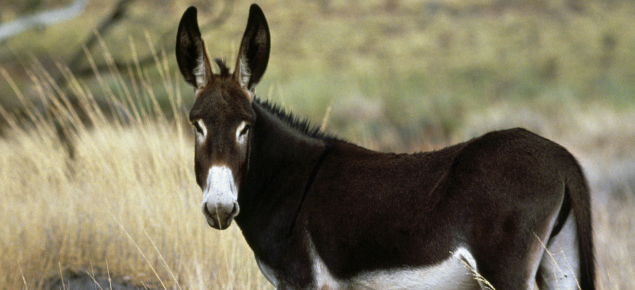Introduction
Donkeys (Equus asinus) were first imported in substantial numbers into Australia in 1866 by Sir Thomas Elder. They were used as pack and draught animals in outlying areas of Western Australia (WA) until the 1930s. They were eventually replaced by the motor vehicle and unwanted donkeys were released to the wild where they became feral. The first record of feral donkeys is from the Kimberley in the early 1930s but it is possible that some became feral much earlier.
Distribution
Feral donkeys occur in pastoral areas of WA, most commonly in the Murchison, Pilbara and Kimberley region, extending into the Goldfields. Control programs have resulted in local eradication of the donkey from some pastoral leases in the Kimberley.
Habitat
In the dry season in the Kimberley donkeys concentrate on the flats of major river and creek systems. Fewer are seen on the lower slopes, foothills and along the minor creeks, while a few occur in hilly country. Their distribution is similar to that of cattle in the same areas at the same time of year.
In the Pilbara donkeys inhabit breakaway country, especially the ‘pea bush’ flats; they are also found in areas of mulga and other acacia species.
In the Goldfields feral donkeys are confined to eucalypt sandplains with granite hills and to some lake systems.
Food habits
Feral donkeys are versatile foragers. They eat a wide variety of grasses, herbs and bushes.
Biology
Donkeys can reduce their evaporative water loss when they become dehydrated. They are able to reduce the water content of their faeces and can continue to eat when deprived of water. They can tolerate extreme loss of body water. These abilities have contributed to their success as a feral animal in Australia.
In hot, dry conditions they do not move far from water, preferring to drink every day. Their home ranges vary widely in size, depending on the habitat. In arid areas home ranges average 32km². This may be reduced to 19km² in less arid areas while in the best grassland habitat average range size may be as low as 3km². The home ranges of individuals overlap substantially.
Feral donkeys live in social groups which may contain either or both sexes. The composition of such groups is unstable, with some individual animals moving between groups.
In the Kimberley feral donkeys produce foals between July and March; most are born when green feed is available. Both female (jennie) and male (jack) become sexually mature at about two years of age.
Damage
Feral donkeys utilize the same food as domestic stock, this is a problem particularly where food is scarce. In other parts of the world overgrazing by donkeys has altered the composition of desert vegetation. Their pads or trails contribute to soil erosion, especially where they move regularly to and from water. They sometimes foul water holes and may prevent other animals from drinking.
Control
Feral donkeys are declared pests of agriculture in WA under the Biosecurity and Agriculture Management Act, 2007 and programs are in place to control them in the wild. The primary means of control is by shooting from helicopters.
This procedure has been improved by the ‘Judas’ technique where selected donkeys are fitted with radio transmitter collars. These collared Judas animals are left to join up with other donkeys.
When a Judas animal is later radio-tracked, any companion feral donkeys can be identified and destroyed, leaving the Judas animal free to roam and locate other herds.
In the Kimberley other control methods, such as shooting for pet food, is of limited value because of large distances, rough terrain and the logistics of bringing product to the market. Trapping at watering places has variable results as some areas have too many alternative water sources. Feral donkeys are difficult to muster because of their habit of breaking away when driven. Shooting from the ground is difficult in rough terrain. However these techniques may have some value in other areas.
Further information
For further information on feral donkeys and feral donkey control, contact the Pest and Disease Information Service.


